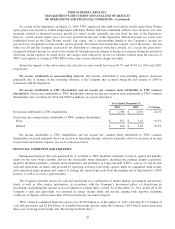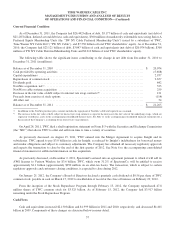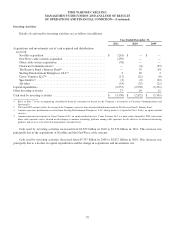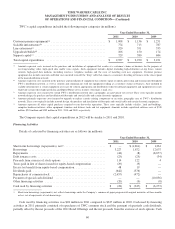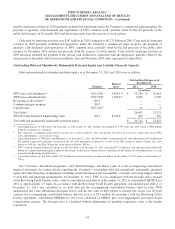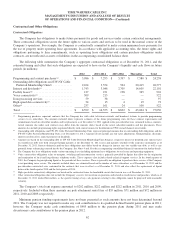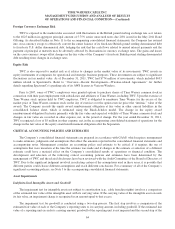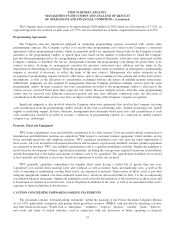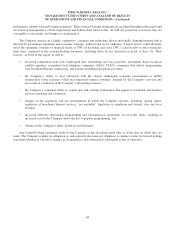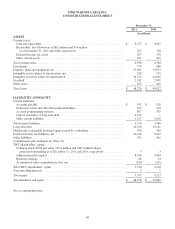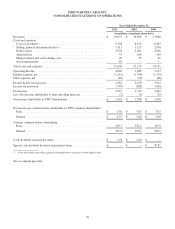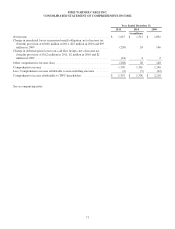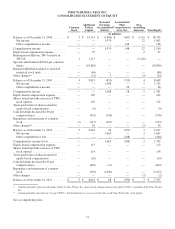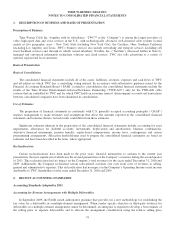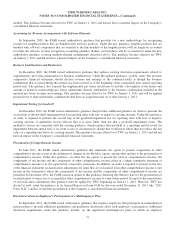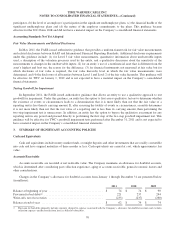Time Warner Cable 2011 Annual Report Download - page 74
Download and view the complete annual report
Please find page 74 of the 2011 Time Warner Cable annual report below. You can navigate through the pages in the report by either clicking on the pages listed below, or by using the keyword search tool below to find specific information within the annual report.TIME WARNER CABLE INC.
MANAGEMENT’S DISCUSSION AND ANALYSIS OF RESULTS
OF OPERATIONS AND FINANCIAL CONDITION—(Continued)
in assessing and estimating the tax consequences of these transactions. The Company prepares and files tax returns based on
interpretation of tax laws and regulations. In the normal course of business, the Company’s tax returns are subject to
examination by various taxing authorities. Such examinations may result in future tax, interest and penalty assessments by these
taxing authorities. In determining the Company’s tax provision for financial reporting purposes, the Company establishes a
reserve for uncertain income tax positions unless such positions are determined to be more likely than not of being sustained
upon examination, based on their technical merits. That is, for financial reporting purposes, the Company only recognizes tax
benefits taken on the tax return that it believes are more likely than not of being sustained. There is considerable judgment
involved in determining whether positions taken on the tax return are more likely than not of being sustained.
The Company adjusts its tax reserve estimates periodically because of ongoing examinations by, and settlements with,
the various taxing authorities, as well as changes in tax laws, regulations and interpretations. The consolidated tax provision
of any given year includes adjustments to prior year income tax accruals that are considered appropriate and any related
estimated interest. The Company’s policy is to recognize, when applicable, interest and penalties on uncertain income tax
positions as part of income tax expense. Refer to Note 17 to the accompanying consolidated financial statements for further
details.
Legal Contingencies
The Company is subject to legal, regulatory and other proceedings and claims that arise in the ordinary course of
business. The Company records an estimated liability for those proceedings and claims arising in the ordinary course of
business when the loss from such proceedings and claims becomes probable and reasonably estimable. The Company
reviews outstanding claims with internal and external counsel to assess the probability and the estimates of loss, including
the possible range of an estimated loss. The Company reassesses the risk of loss as new information becomes available and
adjusts liabilities as appropriate. The actual cost of resolving a claim may be substantially different from the amount of the
liability recorded. Differences between the estimated and actual amounts determined upon ultimate resolution, individually
or in the aggregate, are not expected to have a material adverse effect on the Company’s consolidated financial position but
could possibly be material to the Company’s consolidated results of operations or cash flow for any one period.
Pension Plans
TWC sponsors qualified noncontributory defined benefit pension plans covering a majority of its employees. TWC also
provides a nonqualified noncontributory defined benefit pension plan for certain employees. Pension benefits are based on
formulas that reflect the employees’ years of service and compensation during their employment period. The Company
recognized pension expense associated with these plans of $123 million, $117 million and $162 million in 2011, 2010 and
2009, respectively. The pension expense recognized by the Company is determined using certain assumptions, including the
expected long-term rate of return on plan assets, the interest factor implied by the discount rate and the expected rate of
compensation increases. TWC uses a December 31 measurement date for its pension plans. See Notes 3 and 15 to the
accompanying consolidated financial statements for additional discussion. The determination of these assumptions is
discussed in more detail below.
The Company used a discount rate of 5.90% to compute 2011 pension expense, which was determined by the matching
of plan liability cash flows to a portfolio of bonds individually selected from a large population of high-quality corporate
bonds. A decrease in the discount rate of 25 basis points, from 5.90% to 5.65% while holding all other assumptions constant,
would have resulted in an increase in the Company’s pension expense of approximately $17 million in 2011.
The Company’s expected long-term rate of return on plan assets used to compute 2011 pension expense was 8.00%. In
developing the expected long-term rate of return on assets, the Company considered the pension portfolio’s composition, past
average rate of earnings, discussions with portfolio managers and the Company’s asset allocation targets. A decrease in the
expected long-term rate of return of 25 basis points, from 8.00% to 7.75%, while holding all other assumptions constant,
would have resulted in an increase in the Company’s pension expense of approximately $4 million in 2011.
The Company used an estimated rate of future compensation increases of 4.25% to compute 2011 pension expense. An
increase in the rate of 25 basis points, from 4.25% to 4.50%, while holding all other assumptions constant, would have
resulted in an increase in the Company’s pension expense of approximately $7 million in 2011.
66


